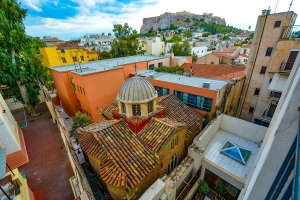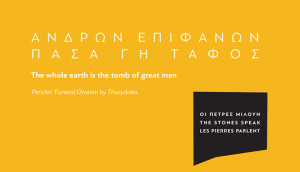WELLNESS HUB
XpatAthens
Athens Olympic Museum: A World-Class Venue For Business & Culture
- Capacity: Up to 35 guests
- Area: 63 m²
1896 Event Hall
- Capacity: Up to 140 guests (various layouts)
- Area: 160 m²
Foyer 1896
- Capacity: Up to 200 guests
- Area: 350 m²
- Capacity: Up to 200 guests (various layouts)
- Area: 370 m²
Lounge
- Capacity: Up to 30 guests
- Area: 75 m²
- Corporate Events: Conferences, seminars, product launches, and team-building sessions are elevated by the museum’s inspiring atmosphere and premium facilities.
- Cultural Gatherings: Host exhibitions, book presentations, panel discussions, or creative workshops in a venue that champions the values of culture and education.
- Private Celebrations: From milestone birthdays to elegant receptions, the museum’s unique design creates a memorable backdrop for personal moments.
- Children’s Parties & Educational Events: The museum offers a fun, educational experience for kids, combining entertainment with hands-on learning about Olympic history and values.
Why Choose the Olympic Museum?
ACS Athens (American Community Schools)
Mission Statement
ACS Athens is a student-centered international school, embracing American educational philosophy, principles and values. Through excellence in teaching and diverse educational experiences, ACS Athens challenges all students to realize their unique potential: academically, intellectually, socially and ethically -- to thrive as responsible global citizens.
Accreditation
The school has been re-accredited until 2022 by Middle States Association of Colleges and Schools under the Sustaining Excellence Protocol.
The Institution (District)
The American Community Schools of Athens is a private, non-profit, pre-K-12 institution, governed by a 18 member Board of Trustees, which has served the children of the American, international and local communities in Athens since 1945. The faculty of ACS Athens is comprised of 96 full-time and 23 part-time certified teachers and specialists, most of whom are US trained; 69 hold Master’s degrees: 10 have pursued advanced studies beyond the Master’s level: and 11 have earned Doctorates. Faculty members attend workshops and conferences sponsored by the Near East/South Asia Council of International schools (NESA), the European Council of International Schools (ECIS), the International Baccalaureate Organization (IBO), U.S subject-area professional organizations, and other leading educational instit tions. ACS Athens is fully accredited by the Middle States Association of Colleges and Schools.
The Community
Located on an enclosed, privately-owned campus in the Athens suburb of Halandri, ACS Athens is housed in five main buildings. The city of Athens has approximately 4 million residents. ACS Athens students are non-boarding and live in all parts of the metropolitan area. The campus is located in the Northern Athens suburb of Halandri (5 km from the center of Athens) on the foothills of Hymettus Mountain and the school is easily accessible from the airport or the different boroughs of Athens, via car, the metro or bus. ACS Athens students are made up of 44 nationalities, including 22% American, 41% Greek and 37% other nationalities.
The High School Academy
The Academy is a comprehensive four-year high school enrolling 400 students in grades nine through twelve. Students engage in a tech rich environment, through a Bring Your Own Device (BYOD) program, and are additionally supported with two technology labs and two mobile laptop carts, and a state of the art media center. Students have daily access to fully equipped science laboratories, a professional theater, a fine arts suite, music and dance studios, an indoor gymnasium with a rock climbing wall, a weight-training room, a swimming pool, soccer field, outdoor basketball, volleyball and tennis courts, and two library/media centers, which contain one of the largest collection of English Language books in Greece. The faculty has incredible teaching experience averaging over 20 years.
The Curriculum
All graduates of the ACS Athens Academy (grades 9-12) earn a United States High School Diploma and follow a college preparatory course of study. To receive a US diploma, students must earn twenty-six Carnegie units, including successful completion of four years of English and Social Studies, three years each of Mathematics, Science and Modern Languages, two years of Physical Education, and one year each of Arts and Technology.
IB, AP and Honors Courses
ACS Athens is authorized to offer the International Baccalaureate Diploma Program® (IB), through which a student may earn the Greek High School Equivalency Diploma (Isotimia). College Board also authorizes ACS Athens to offer select Advanced Placement® (AP) courses in multiple subjects. Currently 61% of the upper class is enrolled in the IB Diploma program and more than 87% of the remaining students have designed a program that combines IB and AP courses where they are enrolled in more than one IB or AP course. Students may use credits earned from AP, IB and internally developed honors courses to pursue the ACS Athens Scholars Diploma.
Honors courses are offered in English, social studies, mathematics, science, foreign languages, and visual and performing arts. Over 98% of ACS Athens graduates are admitted to colleges and universities around the world, primarily in the United States, Canada and United Kingdom; 9 out of 10 of them enroll in one of their top two choices. Our counseling team in the Office of Student Affairs assists graduates to earn academic merit and need-based scholarships for their undergraduate studies; ACS Class of 2018 received over $900,000 in such funds.
Activities/Community Service
A co-curricular program of cultural, social and service activities in all three schools supplements the core curriculum. Activities include National Honor Society, Honor Code, House System, IB
Council, Model United Nations, UNESCO, Chemistry and Technology, Forensics, Yearbook, Literary Magazine, Backgammon/Chess, Youth 2 Youth Project, Dance, Ping Pong, Charity and Recycling.
Clubs and Athletics
ACS Athens is a member of the Sports Council of International Schools (SCIS) and the International Schools Sports Tournament (ISST). Students participate in a wide variety of inter-scholastic cultural activities, academic and athletic competitions sponsored by these organizations, as well as in locally organized tournaments. Athletics include soccer, volleyball, cross country, basketball, swimming, track and field, and tennis – for boys and girls.
Limnos: The island of Hephaestus
The tasteful thyme honey and the fresh fish are also some of the great gifts of nature to the lucky island.
The history of Lemnos is lost in the mists of time. According to mythology, Hephaestus had his forge on the island and taught its first residents, the Sinties, the art of processing copper. The Island flourished during prehistoric times. In 512BC it was conquered by the Persians, but it regained its liberty after the end of the Persian Wars. Since then, it had been subjugated consecutively by the Romans, the Venetians and the Turks, until its definitive liberation in 1912 during the 1st Balkan War.
Capital of the island is Mýrina, a town beautiful for its traditional paved alleys, its old stone mansions, its promenade by the sea, and last but not least for its Byzantine Castle. The impressive castle that overlooks the town lies on a rocky and steep peninsula, on the hillside of which small deer roam free.
Touring around the island is as much an enviable experience as choosing only some of its beauties to write about is a nasty task. Still, a visit to Lemnos is not complete without having been to:
• The Petrified Forest near the town of Moudros, where one has the chance to see fossilised trunks, leaves, fruit and palm-tree roots aged 20-22 million years.
• The prehistoric settlement of Poliochni which is thought to be the oldest Neolithic city in Europe. Actually, a rectangular building with a double row of stepped seats that had been found on the site resembles a parliamentary architectural structure; that’s why it is presumed to be the oldest parliament discovered in the world!
• The archaeological site of Hephaestia, the prehistoric capital of the Pelasgians, whose glory days lasted well over 2000 years (1000BC to 1200AD). Admire the ruins of a complex of a city built and rebuilt in 10 layers, including palaces, baths, Christian churches, a Hellenistic-Roman theatre, a necropolis, and a sanctuary dedicated to the great goddess Lemnos.
• The two small lakes Alyki and Chortarolimni which constitute wetland habitats, refuge and breeding places for rare and endangered bird species.
• The ideal for skin conditions and urinary system problems thermal springs of Hephaestus, at only 4km from Mýrina.
• The waterfalls near the village of Káspakas, where the waters rush off a height of 15m to create an appealing natural site dotted with small plateaus and tiny ponds.
• The village of Kontiás, one of the biggest and most beautiful ones, which is built on a pine-clad hill and is decorated by traditional stone houses, deserted windmills, and the picturesque church off Ághios Dimitrios with the stone bell tower.
• The gorgeous sandy beaches of the islands, which range from peaceful, remote, romantic to busy and well-organised ones. Especially the water sports lovers will go crazy for the beaches of Thanos, Gomati (treat yourself with the pleasure of rolling on the sand dunes there) and Keros, with the last one being a well-known centre for aquatic pleasures and sports activities. Nevertheless, the repeaters of the island and the locals would answer Platý or Chavoúli should they be asked to choose a beach to appear on a postal card from Limnos.
Source: Visitgreece.gr
Tsipras: We Will Find A Solution Within EU Rules
Greece respects European Union rules and will find a solution to its economic problems within the framework of EU law, Greek Prime Minister Alexis Tsipras said on Wednesday, adding there was no agreement yet, but talks were going in the right direction.
Tsipras and his Syriza party won an election in January on promises of negotiating a debt write-off, the reversal of some reforms and ending fiscal consolidation -- provoking a stand-off with its international creditors like the euro zone.
"I'm very optimistic that we will try to do our best in order to find a common, viable and mutually acceptable solution for our common future," Tsipras said on his first visit to Brussels and after talks with European Commission President Jean-Claude Juncker, European Council President Donald Tusk and European Parliament President Martin Schulz.
"Our goal is to respect the people's sovereignty in Greece and the clear mandate of our people. At the same time we respect the rules of the European Union. We want to recorrect this framework, not to smash this framework and we believe that in this framework we could find a common viable solution," he said.
To read more, please visit thetoc.gr/eng
'Travel Trade Athens' Event Delivers 3000 Hosted Buyer Meetings
Travel Trade Athens, jointly organized by the City of Athens Convention and Visitors Bureau (ACVB) and the European Tour Operators Association (ETOA), is the signature annual trade event for the Greek capital which hosts selected international buyers focused on Athens and Greece.
“The demand for Athens can be maintained as long as the basic conditions for the proper functioning of the city — stability and safety — are maintained for our guests.”
Mayor Kaminis said that the municipality plans to approach new markets and customer groups and build on last year’s impressive tourism
growth in the city through an “even more dynamic and targeted” participation in international tourism events.
Furthermore, he said the municipality will continue to hold fam trips to introduce Athens to foreign tourism professionals and mass media representatives, further improve the image and hospitality services of the Greek capital and upgrade the city’s online presence.
This year’s trade event hosted a total of 88 buyers from 27 countries and active in markets such as MICE (Meetings, Incentives, Conferences and Exhibitions) and LGBT (Lesbian, Gay, Bisexual and Transgender).
The hosted buyers came from Egypt, Argentina, Australia, Bulgaria, Brazil, France, Germany, Denmark, Switzerland, the United States, India, Israel, Italy, China (Hong Kong), Cyprus, Lebanon, Malaysia, Great Britain, Norway, Netherlands, Portugal, Romania, Saudi Arabia, Serbia, Sweden, Turkey and Finland.
In terms of suppliers, 190 Greek tourism professionals were from Athens (70 percent) and other parts of Greece attended the event. According to the organizers, the 3,000 meetings held this year are expected to lead to numerous agreements and partnerships between foreign buyers and Greek tourism businesses. Over 3,500 individual business meetings were recorded between hosted buyers and Greek suppliers during the two previous Travel Trade Athens events.
Standard Athens Transport Ticket To Rise To €1.40 On January 1
To read about Jack's experience of the E-Ticket for Athens, click here.
Greek Komboloi - Lord Of The Beads
To read this article in full, please visit: Greece Is
Image credit: Dimitris Vlaikos
April 11 - It's All About Easter
Please click HERE to view this issue of our newsletter!
Remember to stay connected with us through our weekly newsletter, Facebook, and Twitter!
Athens’ EMST To Be Fully Operational In 2018
Ancient Theater Comes Alive In 3 Prominent Athenian Locations
Starting on Friday, July 5, visitors to Athens will have the chance to experience ancient Greek theater at the Acropolis Museum, the Byzantine and Christian Museum, and the Ancient Agora. Named 'The Stones Speak' (Oi Petres Miloun), the program features a series of theater performances that aim to showcase Greek cultural heritage and blend Greek culture into tourism.
From July to October, a group of young actors will present world-class texts by Homer, Plato, Aristotle, Thucydides, Sophocles, and Aristophanes, every Friday, Saturday, and Sunday from 11:00 to 13:00. The performances will be carried out in French, English, and Greek.
The first performance will take place on July 5 at the Byzantine and Christian Museum. In September the performances will be held at the Ancient Agora and at the Acropolis Museum in October.
Admission to all events is free of charge.
To read this article in full, please visit: Greek Travel Pages












